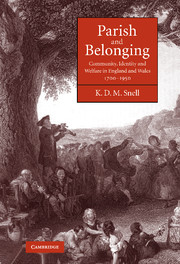Book contents
- Frontmatter
- Contents
- List of figures
- List of tables
- Preface and acknowledgements
- 1 Introduction – belonging and local attachment
- 2 The culture of local xenophobia
- 3 Settlement, parochial belonging and entitlement
- 4 Rural societies and their marriage patterns
- 5 ‘A cruel kindness’: parish out-door relief and the new poor law
- 6 Nailed to the church door? Parish overseers and the new poor law
- 7 Three centuries of new parishes
- 8 ‘Of this parish’: gravestones, belonging and local attachment
- 9 Conclusion – belonging, parish and community
- Select bibliography
- Subject and persons index
- Places index
2 - The culture of local xenophobia
Published online by Cambridge University Press: 27 July 2009
- Frontmatter
- Contents
- List of figures
- List of tables
- Preface and acknowledgements
- 1 Introduction – belonging and local attachment
- 2 The culture of local xenophobia
- 3 Settlement, parochial belonging and entitlement
- 4 Rural societies and their marriage patterns
- 5 ‘A cruel kindness’: parish out-door relief and the new poor law
- 6 Nailed to the church door? Parish overseers and the new poor law
- 7 Three centuries of new parishes
- 8 ‘Of this parish’: gravestones, belonging and local attachment
- 9 Conclusion – belonging, parish and community
- Select bibliography
- Subject and persons index
- Places index
Summary
The social conscience of a rural people is limited by the parish bounds.
Once men begin to feel cramped in their geographical, social and mental habitat, they are in danger of being tempted by the simple solution of denying one section of the species the right to be considered as human.
‘Who's 'im, Bill?’
‘A stranger!’
‘Eave 'arf a brick at 'im.’
This chapter is on the theme of local identity, exclusion and what I am calling ‘the culture of local xenophobia’. ‘Xenophobia’ is an unattractive word, although perhaps that suits its meaning – it is defined as a fear or dislike of things foreign or strange. I shall use it here as prefaced by ‘local’. In other words, this chapter is not dealing with anti-foreigner or anti-outsider sentiments in the more modern international, ethnic or religious senses. In fact, the word ‘foreigner’ was widely used in the past, even as late as the 1940s, to refer to somebody from another parish or locality, and I will normally use it in that local historical way. Such usage connects back to, and further justifies, the term ‘local xenophobia’.
Wider national xenophobic attitudes, whether racist, religious or nationalist, have been much analysed by historians and other academics. Given modern problems, it is very important that study of these issues should occur. By comparison, almost nothing has been written by historians about the subject of local xenophobia, even though that subject bears so much on how, and when, humanitarian attitudes broached parochial confines.
- Type
- Chapter
- Information
- Parish and BelongingCommunity, Identity and Welfare in England and Wales, 1700–1950, pp. 28 - 80Publisher: Cambridge University PressPrint publication year: 2006



